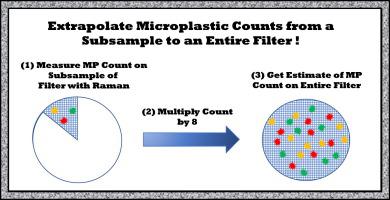Marine Pollution Bulletin ( IF 5.3 ) Pub Date : 2023-05-26 , DOI: 10.1016/j.marpolbul.2023.115073 Dounia El Khatib 1 , Troy D Langknecht 1 , Michaela A Cashman 2 , Mark Reiss 3 , Kelly Somers 4 , Harry Allen 5 , Kay T Ho 2 , Robert M Burgess 2

|
A common method for characterizing microplastics (MPs) involves capturing the plastic particles on a filter after extraction and isolation from the sediment particles. Microplastics captured on the filter are then scanned with Raman spectroscopy for polymer identification and quantification. However, scanning the whole filter manually using Raman analysis is a labor-intensive and time-consuming process. This study investigates a subsampling method for Raman spectroscopic analysis of microplastics (operationally defined here as 45–1000 μm in size) present in sediments and isolated onto laboratory filters. The method was evaluated using spiked MPs in deionized water and two environmentally contaminated sediments. Based on statistical analyses, we found quantification of a sub-fraction of 12.5 % of the filter in a wedge form was optimal, efficient, and accurate for estimating the entire filter count. The extrapolation method was then used to assess microplastic contamination in sediments from different marine regions of the United States.
中文翻译:

使用拉曼光谱评估过滤子采样和外推法以量化环境样品中的微塑料
表征微塑料 (MP) 的常用方法是在从沉积物颗粒中提取和分离塑料颗粒后,在过滤器上捕获塑料颗粒。然后用拉曼光谱扫描过滤器上捕获的微塑料,以进行聚合物识别和定量。然而,使用拉曼分析手动扫描整个过滤器是一个劳动密集型且耗时的过程。本研究研究了一种对沉积物中存在并分离到实验室过滤器上的微塑料(此处操作上定义为尺寸 45-1000 μm)进行拉曼光谱分析的二次采样方法。使用去离子水中加标的 MP 和两种受环境污染的沉积物对该方法进行了评估。根据统计分析,我们发现以楔形形式量化 12.5% 过滤器的子部分对于估计整个过滤器计数而言是最佳、高效且准确的。然后使用外推法评估美国不同海洋区域沉积物中的微塑料污染。











































 京公网安备 11010802027423号
京公网安备 11010802027423号